Are you a Quiet Speculation member?
If not, now is a perfect time to join up! Our powerful tools, breaking-news analysis, and exclusive Discord channel will make sure you stay up to date and ahead of the curve.
In last week's article, I considered a Death's Shadow Zoo variant that gave up some speed for Modern's most efficient interactive spells. The question at the heart of that project: what does a deck gain from leaning further towards interaction or linearity, in relation to the overall metagame?
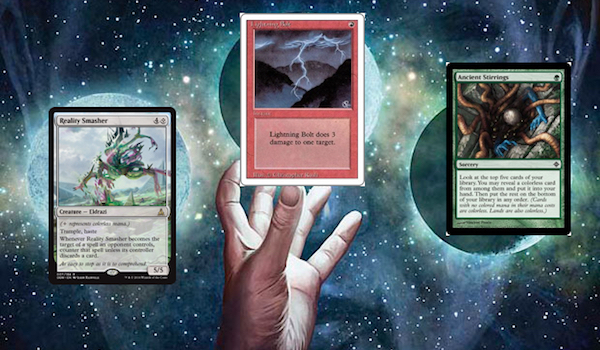
Even obviously linear decks like Infect and Affinity run some amount of disruption in their decks (Dismember, Galvanic Blast, and Spellskite all spring to mind). As streamlined kill-machines, these decks want to pack the smallest amount of interaction possible so they can focus on their own proactive gameplans. But striking a perfect balance can prove difficult. This week, we'll explore how decks decide on a degree of interaction by examining Modern's metagame parameters.
What Are Metagame Parameters?
Just as the existence of Lightning Bolt largely determines benchmark creature playability, metagame parameters are the strategic limits imposed by a format's upper tier that determine deck playability. For example, durdly decks rarely survive in Modern, 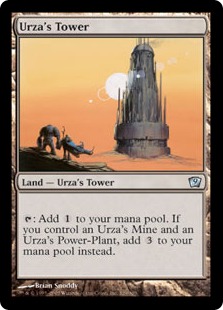 since they lose to Tron. Decks that skimp on removal don't get past Infect. Those relying too heavily on creature synergies struggle against Jund.
since they lose to Tron. Decks that skimp on removal don't get past Infect. Those relying too heavily on creature synergies struggle against Jund.
Combined, these limiting deckbuilding guidelines forge the blueprint for Modern's metagame parameters. While it's impossible to build a deck that beats everything (or at least one that will survive Wizards' diversity-minded banlist), keeping these parameters in mind helps deckbuilders tune and brew successfully.
Modern's metagame parameters force decks to be proactive, interactive, and consistent. Overwhelmingly proactive decks can afford to give up some interaction or consistency, and the same holds true for the other two qualifiers. But most Modern decks attempt to solder the three together. The rest of this article reviews these three primary components of successful Modern decks individually.
Proactivity
The aggro-aligned component, proactivity refers to a strategy's ability to pressure opponents. Linear aggro decks like Burn and Affinity exemplify proactivity in Modern.
Relation to Other Components
Highly proactive decks generally put interactivity on the chopping block before any other component, as they plan on winning before interactive opponents can stabilize the game. As such, trading resources with opponents plays right into the enemy's plan. Death's Shadow Zoo is a great example of a deck so proactive it hardly needs to play any disruption. Outside of a set of Thoughtseize and a pair of Lightning Bolts, the deck doesn't run any mainboard interaction. Why worry about disrupting turn-four combos when you're goldfishing turn-three victories?
The Price of Inaction
For not being proactive enough, Modern reserves nothing but punishment. The biggest feaster on the format's overly interactive decks is Tron. Decks that don't want to win until Turn 10 have a really hard time beating Karn Liberated after Karn Liberated.
Case study: Jeskai Control had trouble putting up numbers in Modern until Nahiri, the Harbinger was released. Nahiri interacts very well with Modern's many midrange decks, but she also plugs a crucial hole against Tron, allowing Jeskai to turn the corner on the fourth turn by ticking up its new planeswalker. Nahiri's ultimate allowed the deck to beat Tron as early as turn six without making an attack during the early game. 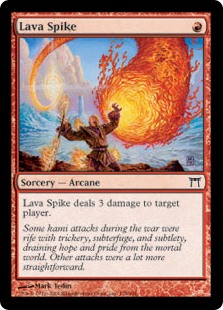 This ability to suddenly turn the corner was also integral to Splinter Twin's success in the format. Twin's out-of-nothing wincon was two turns faster than Nahiri's, and yielded immense success.
This ability to suddenly turn the corner was also integral to Splinter Twin's success in the format. Twin's out-of-nothing wincon was two turns faster than Nahiri's, and yielded immense success.
Burn is another deck that punishes Modern players for not being proactive enough. All the Terminates and Thoughtseizes in the world won't save interactive players from a few Lava Spikes off the top of their opponents' decks. Strategies with reach have the option of transitioning to a burn-'em-out plan potent at defeating opponents who took too long to land a threat.
Red Deck Wins might best showcase this strategy, but Snapcaster Mage decks also wield it well. Against opponents who refuse to put bodies on the board, URx can drop Bolt-Snap-Bolt as early as turn three and start attacking with the blue Wizard. Against these decks, too, stabilizing the board won't always lead to a victory.
Infect and Affinity also boast pseudo-reach effects. Giving Infect too much time often results in the deck's animation of Inkmoth Nexus, followed up with a few pump spells and protection in Vines of Vastwood, Spell Pierce, and Apostle's Blessing, and a lethal swing. Even removal-stocked decks need to put the beats on Infect to prevent these scenarios from occurring. Besides running actual reach in Galvanic Blast, Affinity can topdeck Cranial Plating or Arcbound Ravager and fly over locked-down boards with a creatureland. Etched Champion's "protection from all colors" clause even lets Affinity break through beefy fliers.
When given enough time, these highly proactive decks will find a window to win against overly reactive opponents. They can have trouble executing this sort of plan against proactive opponents, though. With something like Wild Nacatl putting a clock on the linear decks, they have considerably less time to draw outs to interaction.
Metagame Context
- Highly proactive decks: Tron, Infect, Burn, Affinity, Bant Eldrazi, Death's Shadow Zoo, Dredge
- Relatively proactive decks: Jund, Merfolk
- Minimally proactive decks: Jeskai Nahiri
Modern's Top 10 is overwhelmingly proactive, demonstrating the speed and linearity of the format. Since proactive decks often require opponents to be proactive to beat them, highly reactive strategies tend to perform poorly in such fields. For instance, Esper Control is a deck with lots of interaction and consistency, and even less proactivity than Jeskai Nahiri. I don't think it's a coincidence that it sees very little success in Modern, a format full of decks that punish players for not being proactive.
Interactivity
The control-aligned component, interaction refers to a strategy's ability to disrupt opponents. Even aggro decks sometimes choose to interact a little. The most successful of these decks is Jund. Between Tarmogoyf and Dark Confidant, the BGx tyrant is proactive enough for most of Modern, committing threats to the board as of turn two. The reason this slower deck exists alongside blazing piles like Gruul Zoo is its excellent disruption---Jund interacts very efficiently as of turn one, using spells like Inquisition of Kozilek, Lightning Bolt, Abrupt Decay, and Liliana of the Veil to throw opponents off and open the way for two-for-ones aplenty.
Relation to Other Components
Highly interactive decks must give up either proactivity or consistency to function well. Jund 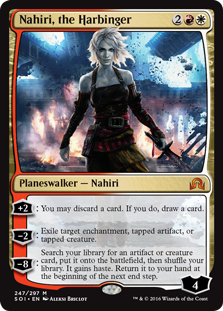 sacrifices consistency, hoping to draw its bombs off the top and preserving the ability to play proactive games against linear opponents with its two-drop threats. Jeskai Nahiri turns the corner much later, but makes up for this loss of proactivity with added consistency from Serum Visions and other draw spells.
sacrifices consistency, hoping to draw its bombs off the top and preserving the ability to play proactive games against linear opponents with its two-drop threats. Jeskai Nahiri turns the corner much later, but makes up for this loss of proactivity with added consistency from Serum Visions and other draw spells.
Since Modern is a turn-four format, many linear decks are built to win on turn four. Proactive decks that aim to win later than that need to start adding interaction. The longer after turn four they aim to win, the more disruption they'll need. And the more disruption they include, the less room they'll have for consistency pieces. This tension was palpable in my project from last week and forms the central dilemma for anyone brewing lategame proactive decks in Modern.
The Answer Problem
Reactive spells are more situational than proactive ones. Slamming Wild Nacatl will always be good for a Zoo deck. For Jeskai, though, Spell Snare is likely to be dead sometimes. Similarly, Remand might be great against Karn Liberated, but it's not so hot versus Signal Pest. Inquisition of Kozilek shines in the Burn matchup and embarrasses against RG Valakut.
Interacting well with a highly aggressive field means giving up some points against big mana. Jund isn't quite proactive enough to put a respectable clock on Tron, which walks all over the Tarmogoyf deck. Like Tron and Burn, Modern's linear combo decks (i.e. Ad Nauseam, Grishoalbrand) excel at going over non-blue interactive strategies like Jund. "Interactive," yeah, but not in the right way for this particular matchup. This problem of answers is the main issue with playing a highly interactive deck in Modern.
Notably, Delver decks perform admirably against Tron and against linear combo. Ryan Overturf solved the midrange problem of not being proactive enough for the Tron matchup by integrating Delver of Secrets into his Grixis deck to impressive success. Given Delver's high proactivity, interactivity, and consistency, I expect we'll see more of the little guy in the near future should Modern remain so linear.
Metagame Context
- Highly interactive decks: Jund, Jeskai Nahiri
- Relatively interactive decks: Merfolk, Bant Eldrazi
- Minimally interactive decks: Affinity, Infect, Burn, Dredge, Death’s Shadow Zoo, Tron
As decks goldfish kills later in the game, they usually move up in interaction. In terms of brewing parameters, a deck that definitely won't win until turn six, such as Temur Scapeshift, needs plenty of interaction to make it in Modern, explaining why that deck is loaded with removal and counterspells.
Consistency
Proactivity and interactivity exist at opposite ends of an axis. Consistency, then, might prove a more contentious inclusion in this piece. The combo-aligned component, consistency refers to a strategy's ability to access the necessary parts of a deck when they're most needed. It means different things to different decks, and each archetype achieves it in a unique way. But ensuring a deck's consistency is often crucial to succeeding in Modern.
Paths to Consistency
Burn gets its infamous consistency through redundancy: it runs 26 copies of the same spell. Jeskai Nahiri gets it by cantripping with Serum Visions and Ancestral Vision.
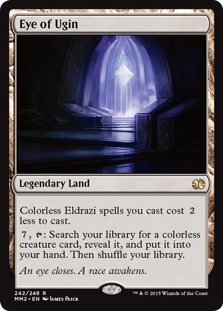 Eldrazi decks used to get their dreaded consistency through redundancy by playing eight Sol lands (or more, if we count Urborg, Tomb of Yawgmoth). Post-Eye of Ugin ban, it gets it by cantripping with Ancient Stirrings, but also by splashing Noble Hierarch. Playing four mini-Dig Through Times isn't enough to ensure an early Thought-Knot Seer. The addition of mana dorks makes the deck's mana development far more consistent.
Eldrazi decks used to get their dreaded consistency through redundancy by playing eight Sol lands (or more, if we count Urborg, Tomb of Yawgmoth). Post-Eye of Ugin ban, it gets it by cantripping with Ancient Stirrings, but also by splashing Noble Hierarch. Playing four mini-Dig Through Times isn't enough to ensure an early Thought-Knot Seer. The addition of mana dorks makes the deck's mana development far more consistent.
Modern decks lacking consistency in Modern are punished by interactive decks. Jund is the primary offender here, although Bolt-Snap-Bolt decks also pose a threat. Any less-than-competent strategy can be easily dismantled by Thoughtseize effects. The same goes for synergy-based creature decks that don't have much consistency.
Those that do include Merfolk with its ton of lords, Elves with a super-dork in Heritage Druid and access to Collected Company, and Company decks in general with dork redundancy in Wall of Roots, a grind game with Kitchen Finks, and various combo finishes. Those that don't include underrepresented archetypes like Allies, Slivers, and Kithkin. These fringe decks lack the consistency to make it in Modern compared with other synergy-based archetypes.
Relation to Other Components
Consistency through redundancy is the preferred method of achieving consistency, since we don't have to invest any time or cards; it just "happens." You know, like with Eye of Ugin. Except Modern's card pool doesn't have enough redundant pieces of staple spells for that plan to be viable for most decks. 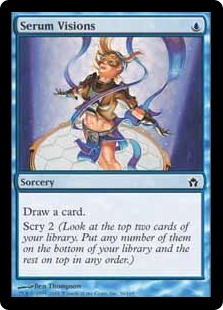 Not every strategy has access to eight Slippery Bogles and 10 Spider Umbras. The next best way to achieve consistency is to add digging spells.
Not every strategy has access to eight Slippery Bogles and 10 Spider Umbras. The next best way to achieve consistency is to add digging spells.
In my mind, Serum Visions, Modern's premier consistency tool, is one of the three best cards in the format (behind Tarmogoyf and of course Lightning Bolt) despite being much worse than Ponder and Preordain. Ancient Stirrings has recently catapulted itself into banlist conversations for the huge consistency boost it grants Eldrazi and Tron.
While powerful, these cards tax players' tempo, or time. If you're spending your turn casting Serum Visions, you're not spending it impacting the board (or, being proactive). Ideally, Visions helps get to spells that interact (or proact) efficiently enough to make up for this initial tempo loss.
Metagame Context
- Highly consistent decks: Burn, Jeskai Nahiri
- Relatively consistent decks: Jund, Infect, Bant Eldrazi, Merfolk, Tron
- Minimally consistent decks: Affinity, Dredge, Death’s Shadow Zoo
While very powerful, Affinity, Dredge, and Death's Shadow Zoo all struggle to recover after opponents deal with their initial assault (respectively via Ancient Grudge, Tormod's Crypt, or Path to Exile). They also mulligan aggressively because they lack consistency. All three of these decks provide great examples of strategies strong enough even with a lackluster hand to not have to lean heavily on consistency.
The Best Decks In Modern
While looking over my Metagame Context sections above, you may have noticed some decks
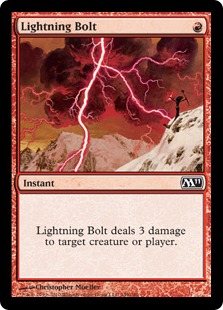 stay closer to the top of the lists than others. Jund is a highly interactive, relatively proactive, relatively consistent deck. Bant Eldrazi is a highly proactive, relatively interactive, relatively consistent deck. These two decks specialize in a component each (respectively, interaction and proactivity), but don’t do so at the cost of giving up too much of the other two. The ability to maintain all components while perfecting one makes them some of the best decks in the format.
stay closer to the top of the lists than others. Jund is a highly interactive, relatively proactive, relatively consistent deck. Bant Eldrazi is a highly proactive, relatively interactive, relatively consistent deck. These two decks specialize in a component each (respectively, interaction and proactivity), but don’t do so at the cost of giving up too much of the other two. The ability to maintain all components while perfecting one makes them some of the best decks in the format.
Prospective deckbuilders must acknowledge Modern’s metagame parameters and adjust their strategies so they are either proactive, interactive, or consistent enough to tangle with the format’s top dogs. I have more to say on the subject, but we’ll leave that for another article. Until then, don’t forget your Lightning Bolts---no matter what component you’re playing for!




Nice article! It seems like a lot of the content here feels like a handful of friends taking turns saying “Hey look I changed a card in my favorite deck again!”, so it’s refreshing to see something more broadly relevant. Theory pieces like this are of great interest to me. 😀
Likewise, I thought this was great. I’m trying to prod Jordan to write more ones like this. 🙂
I agree with Jacob; I love pieces like these. This article helps explain why some of the strongest decks are at the top, and likewise why some decks have a hard time making the cut. Understanding Modern is a key component to being successful at it, and I think this article really helps with that.
This was excellent, and the fact that you took the time to provide examples from the current Top 10 really brought the point home. More articles like this one, please. 🙂
I think that while this is useful for looking at tier 1 decks, it tells a more interesting story about the tier 2 decks. By my count, of the tier 2 decks (ad nauseum, scapeshift, gruul zoo, living end, death and taxes) try to maximize 2 components of proactivity, reactivity, or consistency by completely sacrificing the third, which says that you really do have to have all three components present at some level to succeed.
This is a great point!
+1 to more of this sort of article across the board :). This was a great piece. Your brief mention of delver decks begs the question of what keeps this deck from tier 1 status because it does, as you note, have all three necessary components.
There are two issues with Delver, or at least, with Monkey Grow:
– It takes a lot of damage from lands/Probes.
– It struggles against decks packed with removal (of which there are many).
Bedlam Reveler addresses the second problem, but at the cost of worsening the first—our Burn and linear aggro matchups get significantly worse with the Reveler plan than they were with the Huntmaster plan. But I do think the archetype is underexplored in Modern and very strong, especially given how uninteractive the format is.
Do you think the KLD fastlands will make significant strides to mitigate the life loss?
No, we don’t want any.
To elaborate, Monkeygrow wants to *grow monkeys*. Taking out the fetch-shock package shrinks our goyfs and delays out mandrills. If we got enemy color tango lands, those might be worth looking into restructuring, or at least use as a one or two of to help against Burn, but our fetchlands are absolutely deck critical.
Thank you, i liked the article and agree that these three components are very important! I agree less with the best decks section. In Grand Prix Guangzhou there were 289 decks in day 2, among them 34 jund, 14 nahiri, 12 Abzan (20,7%). In the Top64 there were 1 Jund, 1 Nahiri and 0 Abzan (4,7%). Could still be randomness but i doubt it (the other Grand Prixs were similar). To me the riddle is why there were so many GB lists at Worlds. Maybe the common saying is true that some decks are way harder to play close to their “ceiling” than others. Though the Abzan lists seem also to be better in dealing with Infect/Affinity/Burn than Jund.
Abzan and Jund are pretty similar. The difference is that Abzan is slightly less proactive, but once it gets going, it applies more pressure than Jund. It just takes longer to do it. Siege Rhino and Lingering Souls are more expensive than Dark Confidant, but they are more impactful cards, too.
That means Abzan is better against the aggro decks, as you mentioned, since it wants to grind them out (so does Jund). But it’s even worse against the go-over decks like control and Tron.
In the final section, I didn’t mean to claim that Jund and Bant Eldrazi are literally the best decks in the format. I just wanted to point out that as decks that boast respectable ratings for each component, it’s no wonder they’re so powerful. Jund is the most represented deck in the format by a large margin (about 3%) and Bant Eldrazi, a relative newcomer, has already crunched its way deep into Tier 1.
I feel as if the serum visions statement was bold. It really isn’t good. The card is par for the course of you plan on running a deck containing the wrong half, half the time. Blue isn’t impressive in modern. If you’re honest with yourself, you over credit Jeskai Nahiri. The deck is young.
The deck doesn’t pair well with the current metagame
It doesn’t have the necessary parts to maintain its Tier one status ( my opinion… After 3 years of modern Jeskai)
Jeskai could be as good as jund… if counter spell was printed after 8th edition… and ponder wasn’t banned :). Ultimately your 100% correct with the point your making and you know what the deck is.
Jeskai suffers from a lack of a relevant card pool ( you could say this for any deck any format obviously) thus leading to my expected fall of the deck.
It spends far too much time on the back of its heels with the wrong cards in hand, while serum does the best that it can.
My point is that I can’t wait for the day we talk about Jeskai as if it is a thing, as you have done, but I’m not believing it’s now. Nahiri is a massive leap though!
1) I won’t argue with you since there’s probably no way to convince you. In my opinion though, Serum Visions isn’t just good, it’s one of the best cards in Modern. That can be hard for people used to Ponder and Preordain to grasp. It was hard for me too at first. But card selection is way underrated, even in 2016, when we supposedly know how good it is.
2) I personally don’t think Jeskai is that good, and want to make that clear. I saw the Competitive UWx Control group on facebook post this article and misquote me to claim I was saying Jeskai was one of the best decks in the format, and I control + f’d this article for “Jeskai” after reading your post to see if I’d said anything that would suggest that. The closest I found is when I say the deck became playable with Nahiri introduced, since she made the deck more proactive. It still has very low proactivity.
3) Whether the deck is good or not, Jeskai is at least putting up numbers. If top-tier representation isn’t enough for you to consider a deck “a thing,” I don’t think we can have a productive conversation about this topic.
As far as the three best cards in modern go, im thinking bolt, path, thoughtseize. I sometimes wonder if serum visions is so bad that it could be replaced with another card; it sucks, but just became it is all we have doesn’t mean it is actually good; it is simply a bad magic card.
U: Serum Visions
R: Lightning Bolt
W: Path to Exile
B: Thoughtseize
G: Tarmogoyf
😀 😀 😀